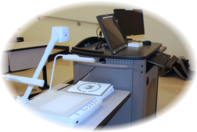Classroom Projector “BLACK SCREEN” Behavior Change
Posted by Malcolm Hays

Between now and the start of the Summer Semester 2012 (Monday, June 4, 2012), Educational Technology will be changing the behavior of the BLACK SCREEN button on all AMX control panels in classrooms.
This behavioral change will cause projectors to automatically shut down if a projector is in the “Black Screen” state for more than 30 minutes.
Pressing BLACK SCREEN a second time–or pressing any other button on the control panel (PC / LAPTOP / DOC CAM / etc.)–will wake up the projector again. Each time BLACK SCREEN is pressed to show a blank screen (i.e. every other time it is pressed), the 30-minute timer will be restarted.
A postcard explaining the behavioral change will be available in every classroom that has been changed.
EdTech routinely finds projectors that have been left on in the “Black Screen” state. Although the projector appears to be “off”, the bulb is still on and is being used by the projector, even in a lower-powered state. Both bulb and projector (fans in particular) suffer from excessive wear and tear by being in the “Black Screen” mode for extended periods of time.
Here is how much EdTech and the University must spend on each projector and bulb (approximately):
| Projector | $1500 |
| Bulb | $400 |
| Other | $Power to run projector (varies) |
Here are some other interesting facts about projectors:
- The typical lifespan of a projector is between 2-4 years (about the same as a computer).
- The typical bulb life is around 2500 “high” hours, where “high” refers to hours where the bulb is fully on projecting a non-black image.
- When a projector is on BLACK SCREEN, it is consuming “low hours”, which do not count towards the “high hours”.
- The replacement warning for a projector only shows when a projector has consumed most of its expected 2500 “high” hours.
- Even when a projector is in “low” (BLACK SCREEN) state, it is consuming 97% of the energy required to run the projector in the “high” state! In other words, when a projector is in the “low” state, it is only 3% more energy efficient than a projector in the fully brightened state.
- Projectors that spend a lot of time in the “low” state will eventually become much dimmer than projectors that spend a lot of time in the “high” state. This is because of the much higher wear-and-tear on the projector and bulb.
- This is especially noticeable in rooms with multiple projectors. In many cases, one projector may display a very bright image–indicating a relatively new, fresh bulb–and the other projector(s) may display a very dim image–indicating a bulb at the end of its lifecycle.
It is in the best interests of the University, IT, and Educational Technology to conserve energy and bulb life where it can be saved. Every projector bulb that EdTech can save means more resources be devoted to obtaining and deploying other technology, such as document cameras and SMART podiums.
PLEASE TURN OFF PROJECTORS WHEN NOT IN USE!